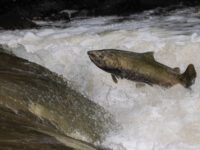The California Department of Food and Agriculture (CDFA) has announced a whole new approach for controlling the light brown apple moth – two of which have been found in Sonoma, causing CDFA to place a 15-square mile area under quarantine.
The new strategy does not use the controversial ground spray – which protesters in several infested counties had forced the state to halt, pending further study – nor even twist ties, which Fish and Game has asked to be further researched. Instead, the plan, which CDFA would “soon be available,” is to saturate the air and disrupt mating with clouds of sterile male moths.
In a prepared statement, California Secretary of Agriculture A.G. Kawamura said Friday, “Since we discovered the light brown apple moth (LBAM) in California in early 2007, we have invested in the development of alternatives that would improve our eradication efforts…We are fast-tracking an approach known as the Sterile Insect Technique (SIT) in which large qualities of sterilized, infertile insects are released so that the wild population cannot reproduce.”
The Invasive Pest Coalition immediately issued a statement praising the decision and asserting the need for eradicating the LBAM for the sake of the “overall environment.” “It is the hope of the IPC that by government officials, farmers and local residents working together we can successfully eradicate the light brown apple moth in a safe and effective manner and prevent future infestations of invasive pests,” said Ted Batkin, Chairman of the IPC. “The IPC believes today’s actions by the California Department of Food and Agriculture using newly available control strategies and a ground based approach is a very positive step in the eradication effort.”
Not everyone believes the eradication – whether with spray, twist ties or sterile males – is necessary. Yannick Phillips, a Sonoma mother of four and independent advocate for agriculture, was influential in postponing the application of twist ties in Sonoma, complaining that the CDFA has not given residents sufficient time, information and choice, and that even Fish and Game had worries about the twist ties’ possible impact on fairy shrimp in the streams.
“I thought, really, this moth is not as bad as what they are talking about!” Phillips said, citing California Farmer articles and a report by UC Santa Cruz arboretum director Dan Harter which shows that a costly eradication program is not needed and not likely to work. “My problem,” she said, “is it’s fiscally irresponsible. We should be saving those funds for when there is an issue. Not for something like this.”
Latest on LBAM: no spray, no twist ties
More from What's HappeningMore posts in What's Happening »
- Chinook Salmon Spotted in Valley Creeks
- Lighted Tractor Parade Set for November 30 on Sonoma Plaza
- Free Thanksgiving Dinner, 3pm at the Veterans Building
- Creative Sonoma Announces #TeachTheArts Campaign to Boost Local Teaching Workforce
- The Living Legacy of Mac McQuown
- “Community Call to Action Town Hall” Draws Concerned Residents






